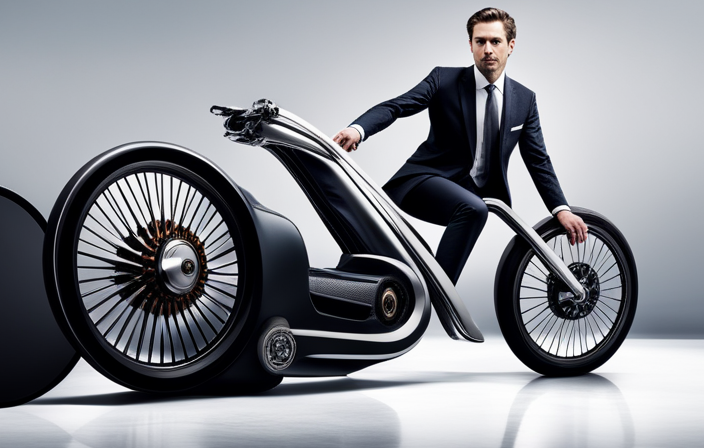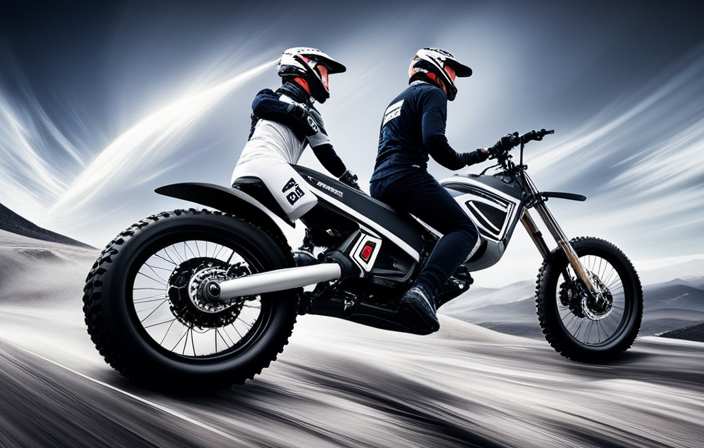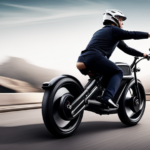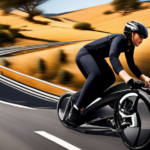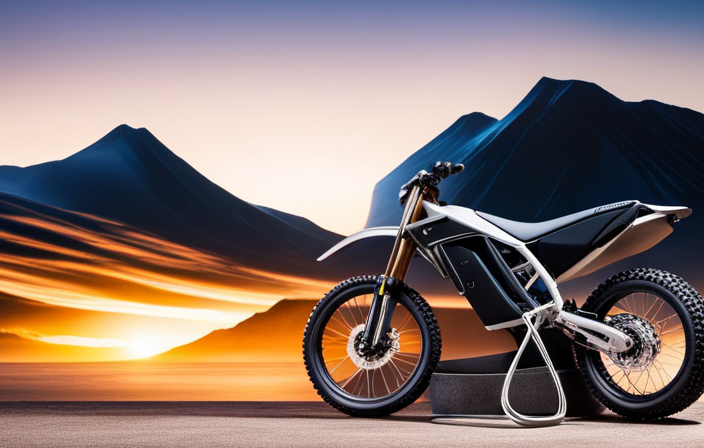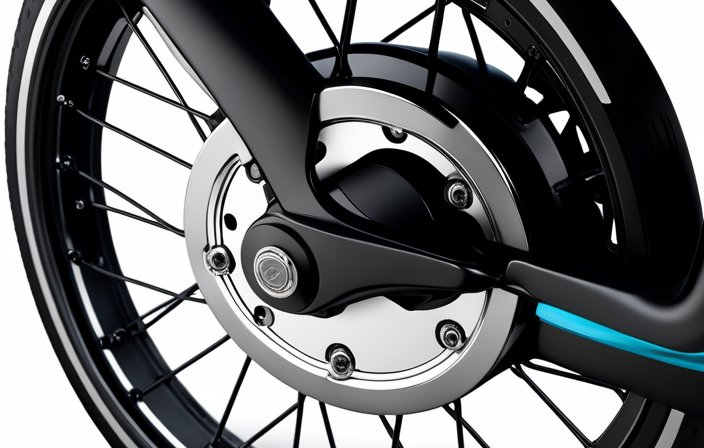Did you know that electric bikes are rapidly gaining popularity, with global sales expected to reach 40 million units by 2025?
In this article, I will provide a technical and detailed explanation of how an electric bike works. We will delve into the various components, such as the battery, motor, controller, and sensors, and explore how they work together to power and control the bike.
Additionally, we will discuss the benefits of electric bikes and the current regulations surrounding them.
Get ready to dive into the fascinating world of electric bikes and discover the future of sustainable transportation.
Key Takeaways
- Electric bikes are equipped with an electric motor for propulsion, allowing for easier and more efficient cycling.
- The components of an electric bike include a battery, motor, and controller, which work together to provide power and control.
- Lithium-ion batteries are commonly used in electric bikes due to their high energy density and long lifespan.
- Electric bikes can have either hub motors or mid-drive motors, each with their own advantages, and the motor power and torque determine the bike’s performance and speed.
An Overview of Electric Bikes
An electric bike, or e-bike, is a bicycle that is equipped with an electric motor to assist with propulsion. Over the years, electric bike advancements have greatly improved their performance and efficiency. These advancements include the development of more powerful and lightweight motors, improved battery technology, and enhanced control systems.
The electric motor on an e-bike works by providing additional power to the rider’s pedaling efforts, making it easier to ride uphill or maintain higher speeds. This not only enhances the overall riding experience but also reduces physical exertion. Moreover, e-bikes have a positive environmental impact as they produce zero emissions and help to reduce air pollution.
Now, let’s delve into the components of an electric bike, starting with the motor and battery system.
The Components of an Electric Bike
The components of an electric bike include a battery, motor, and controller. The electric bike motor is responsible for providing the necessary power to propel the bike forward. It converts electrical energy from the battery into mechanical energy, which drives the wheels.
Electric bike motors come in various types, such as hub motors and mid-drive motors, each with its own advantages and disadvantages. The battery is a crucial component that stores the electrical energy and powers the motor. It can be charged by plugging it into a standard electrical outlet.
The controller acts as the brain of the electric bike, regulating the flow of electricity from the battery to the motor. It ensures smooth and efficient operation of the bike.
Now, let’s delve into how the battery powers the bike.
How the Battery Powers the Bike
The battery is the heart of the electric bike, providing the power needed to propel the bike forward.
Lithium-ion batteries are commonly used in electric bikes due to their high energy density and long lifespan.
Charging the battery is a straightforward process, requiring a compatible charger and a power source.
The battery management system plays a crucial role in ensuring the battery’s longevity and safety by monitoring the battery’s temperature, voltage, and current, and controlling the charging and discharging processes.
Lithium-ion Batteries
Lithium-ion batteries power electric bikes. These batteries are the most commonly used type in electric bikes due to their high energy density, light weight, and long lifespan.
Here are four key points about lithium-ion batteries in electric bikes:
-
Battery Chemistry: Lithium-ion batteries use lithium ions to store and release energy. The battery consists of a positive electrode (cathode), negative electrode (anode), and an electrolyte that allows the ions to move between the electrodes.
-
Energy Density: Lithium-ion batteries offer a high energy density, meaning they can store a large amount of energy in a compact size. This allows electric bikes to have a decent range without being bulky.
-
Charging Speed: Lithium-ion batteries can be charged relatively quickly compared to other battery types. With the right charger, it is possible to charge an electric bike battery to full capacity in just a few hours.
-
Longevity: Lithium-ion batteries have a longer lifespan compared to other battery chemistries commonly used in electric bikes. They can withstand hundreds of charge cycles before their capacity starts to degrade.
With an understanding of lithium-ion batteries, we can now delve into the charging and range of electric bikes.
Charging and Range
Charging and range are important factors to consider when using electric bikes. To maximize the efficiency of the charging process, it is crucial to understand the charging efficiency of the battery.
Lithium-ion batteries, commonly used in electric bikes, have a charging efficiency of around 90-95%. This means that for every 100 watt-hours of energy consumed during charging, only 90-95 watt-hours are stored in the battery.
It is also important to note that the charging efficiency can decrease over time, affecting the battery lifespan. To maintain a good battery lifespan, it is recommended to charge the battery to only 80% of its capacity and avoid completely draining it. This ensures that the battery remains in its optimal operating range, prolonging its overall lifespan.
As we move into the subsequent section about the battery management system, we will explore how it helps in maintaining the battery’s health and performance.
Battery Management System
When it comes to electric bikes, charging and range are crucial factors to consider. But what ensures the optimal performance and lifespan of the battery is the Battery Management System (BMS).
This system is responsible for monitoring and controlling various aspects of the battery, such as temperature, voltage, and current. It helps to prevent overcharging, over-discharging, and overheating, which can all negatively impact battery performance and lifespan. The BMS also ensures that the battery cells are balanced, meaning they all have an equal charge, which helps to maximize the overall capacity of the battery.
Overall, the BMS plays a vital role in maintaining the health and efficiency of the battery, ultimately enhancing the riding experience.
Now, let’s delve into the role of the motor in propulsion.
The Role of the Motor in Propulsion
The role of the motor in propulsion is crucial to understanding how an electric bike works. There are two main types of motors commonly used in electric bikes: hub motors and mid-drive motors.
Hub motors are located in the center of either the front or rear wheel and provide direct power to propel the bike forward.
On the other hand, mid-drive motors are situated in the middle of the bike frame and use a system of gears to transfer power to the crankshaft, providing a more efficient and powerful propulsion.
The power and torque of the motor are key factors in determining the performance and speed of the electric bike, with higher power and torque resulting in greater acceleration and overall speed capabilities.
Hub Motors
To make an electric bike move, you simply pedal and let the hub motor assist you. Hub motors are a popular choice for electric bikes due to their simplicity and efficiency. These motors are located in the center of either the front or rear wheel and are directly connected to the bike’s drivetrain. When you pedal, torque sensors detect the force applied and send a signal to the motor to provide assistance. The hub motor then uses its internal magnets and coils to produce rotational force, which propels the bike forward. This design eliminates the need for additional gears or chains, resulting in a more efficient system.
However, hub motors have their limitations, such as added weight and reduced maneuverability. Transitioning into the discussion of mid-drive motors, they offer a different approach to electric bike propulsion.
Mid-drive Motors
If you want more power and control, consider using a mid-drive motor for your electric bike. Mid-drive motors offer several advantages over hub motors.
One of the main advantages is that they provide better weight distribution, as the motor is mounted in the center of the bike’s frame. This results in a more balanced and stable ride.
Additionally, mid-drive motors allow for better control and handling, as the power is delivered directly to the bike’s drivetrain. This means that the motor can take advantage of the bike’s gears, providing a wider range of power and torque options. In comparison, hub motors are typically limited to a single gear ratio.
Transitioning into the next section, power and torque are crucial factors to consider when choosing the right motor for your electric bike.
Power and Torque
Power and torque are important considerations when selecting a motor for your e-bike. Here are four key points to understand about power and torque in electric bikes:
-
Power efficiency: The motor’s power efficiency determines how effectively it converts electrical energy into mechanical power. Higher power efficiency means less energy wasted and more efficient use of the battery.
-
Torque control: Torque refers to the rotational force that the motor generates. It determines how quickly the bike accelerates and how well it climbs hills. Having good torque control allows for smoother and more controlled power delivery, enhancing the overall riding experience.
-
Power and torque balance: Finding the right balance between power and torque is crucial. Too much power without sufficient torque can result in poor hill climbing ability, while too much torque without adequate power may limit top speed.
-
Motor types: Different motor designs offer varying power and torque characteristics. Hub motors typically provide high torque at low speeds, while mid-drive motors offer a balance between power and torque across a wider range.
Understanding power and torque helps in selecting the right motor for your e-bike, but it’s equally important to comprehend how the controller and sensors control the bike.
How the Controller and Sensors Control the Bike
When it comes to controlling an electric bike, there are two key components: the throttle and the pedal assist system.
The throttle allows me to control the bike’s speed by simply twisting it, similar to a motorcycle.
On the other hand, the pedal assist system uses sensors to detect when I start pedaling and provides an extra boost of power to make pedaling easier.
Additionally, the bike is equipped with speed and torque sensors that constantly monitor my speed and the force I apply to the pedals, allowing for a more efficient and responsive ride.
Throttle and Pedal Assist
To operate an electric bike, you can simply use the throttle or engage the pedal assist feature to assist your pedaling. The throttle control allows you to control the speed of the bike without pedaling. By twisting the throttle, you can increase or decrease the power delivered to the motor, giving you full control over your ride. This feature is especially useful when you need an extra boost or want to maintain a constant speed. On the other hand, the pedal assist feature works by measuring your pedaling power and providing an additional boost based on the level selected. This not only enhances your riding experience but also improves energy efficiency by utilizing your own pedal power. Transitioning into the subsequent section about ‘speed and torque sensors,’ these sensors play a crucial role in determining the amount of assistance provided by the motor.
Speed and Torque Sensors
Speed and torque sensors are essential components that determine the level of assistance provided by the motor on an e-bike. These sensors work together to monitor the speed at which the pedals are turning and the amount of force being applied.
The speed sensor measures the rate at which the pedals rotate, while the torque sensor measures the force being exerted on the pedals. By analyzing this data, the motor control system can adjust the level of pedal assistance accordingly.
For example, if the rider is pedaling slowly with little force, the motor can provide more assistance to help maintain a consistent speed. On the other hand, if the rider is pedaling quickly and with a lot of force, the motor can reduce assistance to allow for a more challenging workout.
Understanding the display and controls is the next step in getting the most out of your e-bike experience.
Understanding the Display and Controls
You can easily understand the display and controls of an electric bike. Here are four key points to consider:
-
Display Customization: Most electric bikes come with a display that allows you to customize various settings. You can adjust the level of assist, monitor battery life, and even track your speed and distance traveled.
-
Troubleshooting Common Display Issues: If you encounter any issues with the display, such as it not turning on or showing incorrect information, there are a few troubleshooting steps you can take. These may include checking the battery connection, ensuring the display is securely attached, or resetting the display settings.
-
Control Panel: The control panel typically consists of buttons or a touch screen interface. It allows you to navigate through different menus, adjust settings, and control the bike’s functions, such as turning on the lights or activating the horn.
-
Handlebar Mounted: The display and controls are conveniently located on the handlebars, within easy reach while riding. This ensures that you can access the necessary information and make adjustments without taking your hands off the handlebars.
Understanding the display and controls is crucial for a smooth and enjoyable electric bike riding experience.
Now, let’s delve into the importance of brakes and gears.
The Importance of Brakes and Gears
Understanding the display and controls of an electric bike is important, but it’s equally crucial to recognize the significance of brakes and gears. The brakes and gears are integral components that ensure smooth and safe riding. Maintaining these components is of utmost importance to ensure their optimal performance.
Regular maintenance such as cleaning, lubricating, and adjusting the brakes and gears can significantly extend their lifespan and improve their efficiency.
When it comes to brakes, there are different types available, including rim brakes, disc brakes, and regenerative brakes. Each braking system has its advantages and disadvantages, and comparing them is essential in choosing the most suitable option for your electric bike. Rim brakes are lightweight and affordable, but they may not provide as much stopping power as disc brakes. On the other hand, disc brakes offer better stopping power and perform well in wet conditions. Regenerative brakes, as the name suggests, can recharge the battery while braking, providing an additional energy-saving feature.
Moving on to gears, they allow you to adjust the bike’s speed and resistance according to the terrain and your preferences. Electric bikes usually have a combination of gears, including a front derailleur and a rear derailleur. The front derailleur controls the bigger chainrings, while the rear derailleur manages the smaller ones. Understanding how to use the gears effectively can enhance your riding experience and make pedaling easier.
In conclusion, the importance of brakes and gears cannot be overstated when it comes to electric bikes. Proper maintenance and understanding the differences between braking systems are crucial for safe and efficient riding.
Now, let’s delve into the next section, which explores the design and construction of the frame and wheels.
The Design and Construction of the Frame and Wheels
Now that we understand the importance of brakes and gears in an electric bike, let’s delve into the design and construction of the frame and wheels.
The frame of an electric bike is typically made of lightweight materials such as aluminum or carbon fiber. These materials provide strength and durability while keeping the overall weight of the bike low. The choice of frame material also affects the ride quality, as different materials have varying levels of stiffness and vibration dampening properties.
In terms of wheels, electric bikes come in a variety of sizes, but the most common wheel size is 26 inches. However, larger wheel sizes, such as 27.5 inches or 29 inches, are becoming increasingly popular due to their improved stability and ability to handle rough terrain.
As we move on to the next section on safety features and accessories, it is important to consider how the design and construction of the frame and wheels play a role in enhancing the overall riding experience and ensuring rider safety.
Safety Features and Accessories
When considering safety features and accessories for your electric bicycle, it’s important to prioritize items such as lights, reflectors, and a sturdy lock to protect against theft. These bike accessories are crucial for ensuring your safety on the road and preventing accidents.
Here are some essential safety precautions to consider:
- Powerful front and rear lights to enhance visibility, especially during low-light conditions.
- Reflective strips or stickers on the frame and wheels to make your bike more noticeable to other road users.
- A loud horn or bell to alert pedestrians and other cyclists of your presence.
- Fenders to keep you protected from water and mud splashes.
- A comfortable and properly fitting helmet to protect your head in case of a fall.
By investing in these safety features and accessories, you can significantly reduce the risk of accidents and enhance your overall riding experience.
Now let’s explore the importance of maintenance and care for electric bikes.
Maintenance and Care for Electric Bikes
To properly maintain and care for your electric bicycle, it’s important to regularly clean and lubricate the moving parts, check tire pressure, and inspect the brakes. This will ensure optimal performance and longevity of your electric bike. Additionally, here are some maintenance tips and troubleshooting common issues you may encounter:
-
Maintenance Tips:
- Keep the battery charged and store it in a cool, dry place.
- Clean the bike regularly, using a mild detergent and a soft cloth.
- Check the chain tension and adjust if necessary.
- Inspect the cables and wires for any signs of wear or damage.
-
Troubleshooting Common Issues: Issue Solution Battery not charging Check the charger connection and replace if needed. Motor not working Ensure the motor is properly connected and check for loose wires. Brakes not responsive Adjust brake pads and check for any debris or contamination. Display not functioning Check the battery connection and replace if necessary.
Regular maintenance and prompt troubleshooting can help keep your electric bike in excellent condition. Now, let’s move on to the next section where we discuss choosing the right electric bike for you.
Choosing the Right Electric Bike for You
Choosing the right e-bike for you involves considering factors such as your riding style, terrain, and budget. It is important to find the right size of electric bike that suits your body type and riding preferences.
Test riding different models can help you determine which one feels the most comfortable and suits your needs. When test riding, pay attention to the bike’s responsiveness, stability, and overall handling.
Additionally, consider the type of terrain you will be riding on. If you plan on tackling steep hills or rough trails, a bike with a more powerful motor and larger battery capacity may be necessary.
Lastly, set a budget that aligns with your financial capabilities and prioritize the features that are most important to you. By finding the perfect e-bike, you can ensure a more enjoyable riding experience.
Transitioning into the next section, understanding how to properly ride and operate an electric bike is essential.
Riding and Operating an Electric Bike
When it comes to starting and stopping an electric bike, it’s important to understand the basic mechanics involved.
To start, simply turn on the bike’s power switch and gently pedal to activate the motor.
To stop, apply the brakes gradually and come to a complete stop before dismounting.
As for riding techniques, it’s crucial to maintain a balanced posture and use a smooth, consistent pedaling motion to maximize efficiency.
Additionally, always be aware of your surroundings and follow traffic laws to ensure safety while riding an electric bike.
Starting and Stopping
Starting and stopping on an electric bike is as simple as pressing the pedals or using the hand brakes. To ensure a smooth start, it’s important to apply gradual pressure to the pedals rather than a sudden jolt. This will prevent any loss of control or jerky movements. Additionally, keeping a balanced posture and distributing body weight evenly will further enhance the starting technique.
When it comes to emergency stopping, the hand brakes should be utilized. Squeezing the brake levers firmly will activate the disc or rim brakes, bringing the bike to a quick halt. It’s crucial to practice emergency stopping in a controlled environment to familiarize oneself with the brake response.
Now, let’s transition to the subsequent section about riding techniques and safety, where we will delve into more aspects of electric bike operation.
Riding Techniques and Safety
Riding an electric bike requires the rider to be familiar with various techniques and safety precautions.
When it comes to riding techniques, it is important to maintain a proper body position and balance to ensure stability. Keeping a relaxed grip on the handlebars and using smooth, controlled movements while shifting gears and braking is essential. Additionally, understanding how to properly use the pedal assist and throttle features can enhance the riding experience.
Safety measures are equally important, such as wearing a helmet and reflective clothing, using hand signals to communicate with other road users, and obeying traffic rules. It is also crucial to regularly check the bike’s brakes, tires, and lights to ensure they are in good working condition.
By mastering these riding techniques and following safety measures, riders can enjoy the benefits of electric bikes, such as eco-friendly transportation and improved physical fitness.
Benefits of Electric Bikes
To fully enjoy the benefits of electric bikes, you’ll find that they provide a convenient and eco-friendly mode of transportation. Electric bikes have several advantages over traditional bicycles.
Firstly, they offer assistance when pedaling, which makes uphill climbs and long distances more manageable. This feature is especially beneficial for individuals with physical limitations or those who want to conserve energy.
Secondly, electric bikes have a minimal environmental impact compared to cars and motorcycles. They produce zero emissions and consume significantly less energy. This makes them a greener alternative for daily commuting, reducing air pollution and carbon footprints.
Lastly, electric bikes can also save you money in the long run. With lower operating costs, cheaper maintenance, and no need for fuel, they are a cost-effective transportation option.
Transitioning into the subsequent section about regulations and laws for electric bikes, it is important to understand the legal requirements in your area to ensure a safe and compliant riding experience.
Regulations and Laws for Electric Bikes
Before you hit the road on your e-bike, it’s important to understand the regulations and laws that apply to them in your area. Electric bike speed limits and licensing requirements for electric bikes vary depending on the jurisdiction.
In some places, electric bikes are classified as bicycles and are subject to the same speed limits as traditional bicycles. However, other areas may have specific speed limits for electric bikes, typically ranging from 20 to 28 mph.
As for licensing requirements, many jurisdictions do not require a special license or registration for electric bikes that meet certain criteria, such as having a maximum power output of 750 watts and a top speed of 20 mph.
It is crucial to familiarize yourself with the specific regulations in your area to ensure compliance and safe riding.
In the future, as electric bikes continue to gain popularity, it is likely that regulations and laws will evolve to accommodate their increasing presence on the roads.
Transitioning into the next section, the future of electric bikes holds exciting possibilities for transportation and environmental sustainability.
Conclusion: The Future of Electric Bikes
In the coming years, we can expect to see significant advancements in the technology and infrastructure surrounding e-bikes. With the increasing demand for eco-friendly transportation options, the future of electric bikes looks promising.
One of the key areas of development will be in battery technology, as manufacturers strive to improve the range and efficiency of e-bikes. We can also anticipate the integration of smart features, such as GPS navigation and smartphone connectivity, making e-bikes more user-friendly and convenient.
Another aspect that will likely be addressed is the environmental impact of e-bikes. Efforts will be made to reduce the carbon footprint of e-bike production and disposal, as well as to promote sustainable charging methods.
Overall, the future of electric bikes holds great potential for both technological advancements and positive environmental impact.
Frequently Asked Questions
How long does the battery of an electric bike typically last before needing to be replaced?
The battery lifespan of an electric bike can vary depending on usage, but on average, it may last around 2-5 years before needing to be replaced. Signs of a dying battery include decreased range and reduced performance.
Is it possible to ride an electric bike without using the motor?
Yes, it is possible to ride an electric bike without using the motor. By using proper riding techniques, such as pedaling efficiently and managing gears, you can enjoy the benefits of exercise and conserve battery power for longer rides.
Can an electric bike be ridden in the rain or through puddles?
When riding an electric bike in the rain or through puddles, it is important to maintain a proper riding technique and take necessary maintenance precautions. This includes avoiding deep water and ensuring the bike’s electrical components are properly protected.
Are electric bikes allowed on bike paths and trails?
Yes, electric bikes are generally allowed on bike paths and trails, but regulations may vary. They offer benefits such as increased speed and range, making them a convenient and eco-friendly mode of transportation.
How much does an electric bike typically weigh compared to a regular bike?
An electric bike typically weighs more than a regular bike due to the additional components such as the battery and motor. The weight can range from 40 to 70 pounds depending on the model. Battery life varies based on usage and can range from 20 to 80 miles.
Conclusion
In conclusion, electric bikes are revolutionizing the way we commute and explore our surroundings.
With their efficient components, such as the battery, motor, controller, and sensors, electric bikes provide a seamless riding experience.
One interesting statistic is that electric bikes can reach speeds of up to 20 miles per hour, allowing riders to effortlessly cover long distances in a shorter amount of time.
As regulations and laws continue to evolve, the future of electric bikes looks promising, offering a sustainable and convenient transportation option for individuals worldwide.
